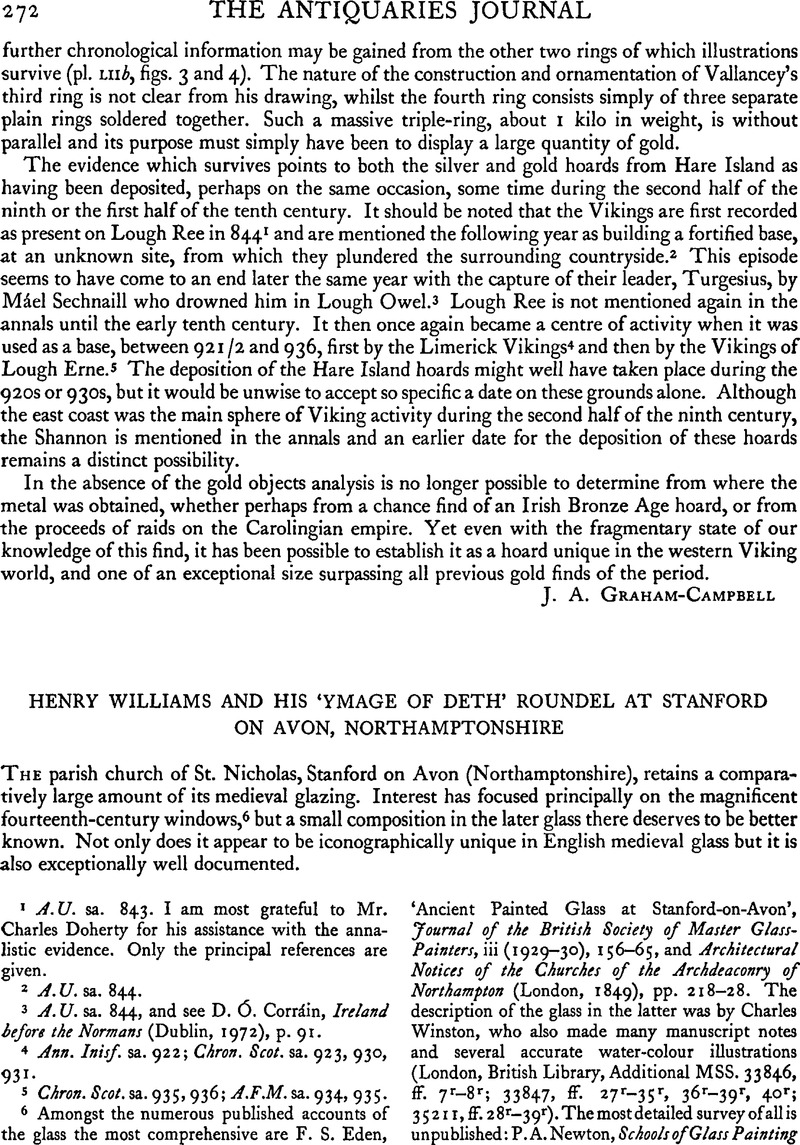No CrossRef data available.
Article contents
Henry Williams and his ‘Ymage of Deth’ Roundel at Stanford on Avon, Northamptonshire
Published online by Cambridge University Press: 29 November 2011
Abstract

- Type
- Notes
- Information
- Copyright
- Copyright © The Society of Antiquaries of London 1974
References
page 272 note 6 Amongst the numerous published accounts of the glass the most comprehensive are Eden, F. S., ‘Ancient Painted Glass at Stanford-on-Avon’, Journal of the British Society of Master Glass-Painters, iii (1929–1930), 156–65Google Scholar, and Architectural Notices of the Churches of the Archdeaconry of Northampton (London, 1849), pp. 218–28Google Scholar. The description of the glass in the latter was by Charles Winston, who also made many manuscript notes and several accurate water-colour illustrations (London, British Library, Additional MSS. 33846, ff. 7r–8r; 33847, ff. 27r–35r, 36r–39r, 40r; 35211, ff. 28r–39r). Themost detailed survey of all is unpublished: Newton, P. A., Schools of Glass Painting in the Midlands, 1275–1430 (University of London Ph.D. thesis, 1961), i, pp. 2–3, 29–35Google Scholar; ii, pp. 358–91. A complete catalogue and analysis of the glazing will appear in my volume on the medieval glass of Northamptonshire, Huntingdon and Peterborough, and Stamford in the Corpus Vitrearum Medii Aevi series.
page 273 note 1 The dimensions of the whole light are 33·5 × 24·5 cm.
page 273 note 2 Bridges, J., The History and Antiquities of Northamptonshire, i (Oxford, 1791), p. 581Google Scholar. He is possibly identifiable as the Henry Williams who supervised the will of Alice Dobbis of Oxford in 1488; see Emden, A. B., A Biographical Register of the University of Oxford to A.D. 1500, iii (Oxford, 1959), p. 2050Google Scholar.
page 273 note 3 London, British Library, Lansdowne MS. 1028, f. 246r. A transcript is printed in R. M. Serjeantson and Longden, H. Isham, ‘The Parish Churches and Religious Houses of Northamptonshire: their Dedications, Altars, Images and Lights’, Arch. Journ. lxx (1913), 407Google Scholar. The original will apparently does not survive.
page 273 note 4 London, British Library, Lansdowne MS. 1042, f. 10r (W. Taylor notes). The letters in round brackets are expansions of the abbreviations, those in the square ones are my reconstruction.
page 273 note 5 There are mentions in wills dated 1519 and 1538 of St. John's aisle and altar which must have been in the nave as the chancel is unaisled (Serjeantson, and Longden, Isham, op. cit., 407)Google Scholar.
page 273 note 6 Curiously enough, another instance appears to be in the east window of Stanford on Avon, where at the base of the fourteenth-century glass is an incomplete series of members of Sir Thomas Cave's (d. 1558) family. A quite well-known example is in the glass of Chartres Cathedral, where in 1328 Canon William Thierry had the bottom section of a thirteenth-century window depicting the Nine Orders of Angels and the story of St. Apollinaris replaced by figures of himself, the Virgin, and various saints. See Delaporte, Y. and Houvet, E., Les Vitraux de la Cathédrale de Chartres (Chartres, 1926), pp. 21, 196–205Google Scholar, pl. xxxii.
page 274 note 1 The cause of this morbid outlook has often been said to have been the Black Death and the outbreak of the Hundred Years War. However, one of the most popular pictorial manifestations of this theme, ‘The Three Living and the Three Dead Kings’, was inspired by four thirteenth-century poems, and the earliest representations date from late in the same century. See Williams, E. Carleton, ‘Mural Paintings of the Three Living and the Three Dead in England’, J.B.A.A., 3rd series, vii (1942), 31–2Google Scholar.
page 274 note 2 Williams directed that his body should be buried in the churchyard, and his stained-glass panels fulfilled the function of a sepulchral monument.
page 274 note 3 See the list given in Haines, H., A Manual of Monumental Brasses (first published 1861, new edition Bath, 1970), pp. ccxvii–ccxviiiGoogle Scholar. All those mentioned are of post-Reformation date, but to them can be added the fragmentary brass of Archdeacon John Rudyng (d. 1481) at Biggleswade (Bedfordshire), which has Death pointing with a long spear to the word ‘mors’ in the verse inscription below the indent of the kneeling figure of the deceased (Griffin, R., ‘A Brass once in Biggleswade Church’, Antiq. Journ. xvi (1936), 284–90CrossRefGoogle Scholar, pl. XLVIII).
page 274 note 4 London, British Library, Additional MS. 37049, f. 84v. I have followed the dating of Freud, D., The Desert of Religion (University of London M.A. report, 1973), p. 36Google Scholar.
page 274 note 5 Religious Lyrics of the XVth Century, ed. Brown, Carleton (Oxford, 1939), p. 241.Google Scholar


